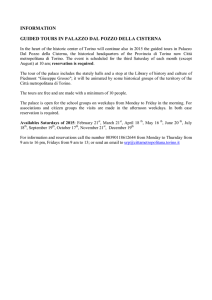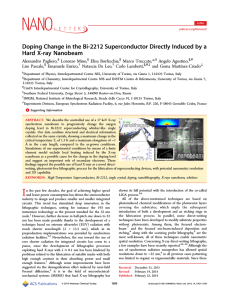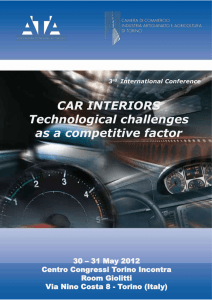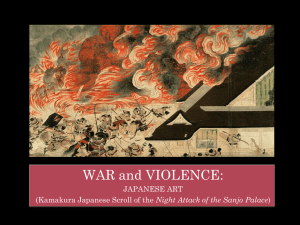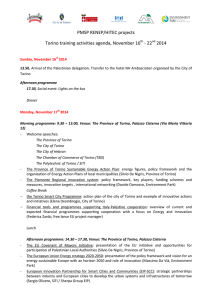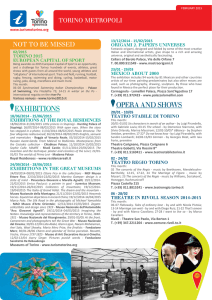information guided tours in palazzo dal pozzo della cisterna
advertisement
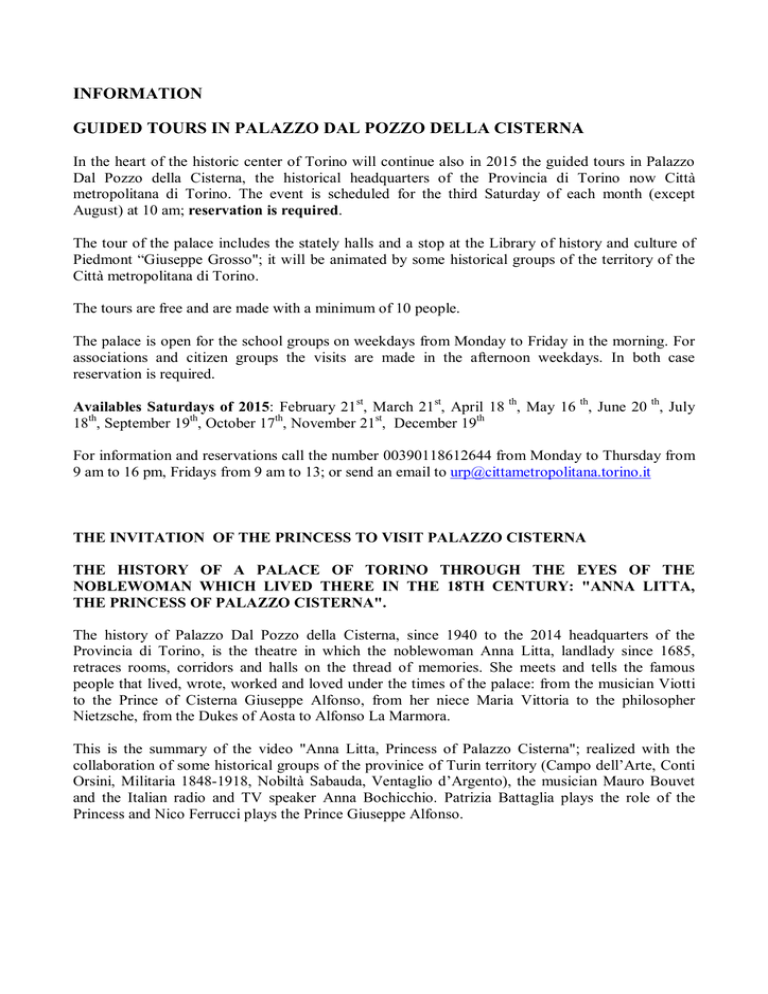
INFORMATION GUIDED TOURS IN PALAZZO DAL POZZO DELLA CISTERNA In the heart of the historic center of Torino will continue also in 2015 the guided tours in Palazzo Dal Pozzo della Cisterna, the historical headquarters of the Provincia di Torino now Città metropolitana di Torino. The event is scheduled for the third Saturday of each month (except August) at 10 am; reservation is required. The tour of the palace includes the stately halls and a stop at the Library of history and culture of Piedmont “Giuseppe Grosso"; it will be animated by some historical groups of the territory of the Città metropolitana di Torino. The tours are free and are made with a minimum of 10 people. The palace is open for the school groups on weekdays from Monday to Friday in the morning. For associations and citizen groups the visits are made in the afternoon weekdays. In both case reservation is required. Availables Saturdays of 2015: February 21st, March 21st, April 18 th, May 16 th, June 20 th, July 18th, September 19th, October 17th, November 21st, December 19th For information and reservations call the number 00390118612644 from Monday to Thursday from 9 am to 16 pm, Fridays from 9 am to 13; or send an email to urp@cittametropolitana.torino.it THE INVITATION OF THE PRINCESS TO VISIT PALAZZO CISTERNA THE HISTORY OF A PALACE OF TORINO THROUGH THE EYES OF THE NOBLEWOMAN WHICH LIVED THERE IN THE 18TH CENTURY: "ANNA LITTA, THE PRINCESS OF PALAZZO CISTERNA". The history of Palazzo Dal Pozzo della Cisterna, since 1940 to the 2014 headquarters of the Provincia di Torino, is the theatre in which the noblewoman Anna Litta, landlady since 1685, retraces rooms, corridors and halls on the thread of memories. She meets and tells the famous people that lived, wrote, worked and loved under the times of the palace: from the musician Viotti to the Prince of Cisterna Giuseppe Alfonso, from her niece Maria Vittoria to the philosopher Nietzsche, from the Dukes of Aosta to Alfonso La Marmora. This is the summary of the video "Anna Litta, Princess of Palazzo Cisterna"; realized with the collaboration of some historical groups of the provinice of Turin territory (Campo dell’Arte, Conti Orsini, Militaria 1848-1918, Nobiltà Sabauda, Ventaglio d’Argento), the musician Mauro Bouvet and the Italian radio and TV speaker Anna Bochicchio. Patrizia Battaglia plays the role of the Princess and Nico Ferrucci plays the Prince Giuseppe Alfonso. A LITTLE HISTORY HISTORY OF THE PALACE Nowadays the palace is located on the ancient “Assunta” block delimited by Bogino, Giolitti, Carlo Alberto and Maria Vittoria streets. The original nucleus of the building - Count Flaminio Antonio Ripa di Giaglione’s property – date back to 1675. The present garden area is added three years after, In 1685 the complex passes to Dal Pozzo della Cisterna family who enriches and embellishes progressively the structure. Many restructuring and amplification works, projected by the royal architect Francesco Valeriano Dellala di Beinasco, started from the second half of the 1700 and concluded under prince-patron Giuseppe Alfonso; so the west sleeve is remodelled and the front is arranged, a new stable is built. Skilful artisans and craftsmen execute decorations in wood, stucco and iron. The palace is a good example of Piedmonts Baroque, findable nowadays on the sober Via Maria Vittoria façade. In the years between the end of 1700 and the first decades of 1800 the life of the palace slows down and starts again in 1867 following the marriage between Maria Vittoria, daughter of Carlo Emanuele della Cisterna, and Amedeo di Savoia, Duke of Aosta. The palace becomes a representative house, very magnificent: new rooms are added, coffered ceiling are realized, polychrome glazed are placed, gildings and silken tapestries are applied. After the Princess Maria Vittoria's dead, by will of her husband Amedeo d’Aosta, the work in the palace continues. Was approved the project for the construction of the railing that surrounding the garden on Via Carlo Alberto (which replaced the old boundary wall) and the project of the reconstruction of the great representation staircase. Always from this period are some technological improvements, like the gas lighting in the hall and the work of raising the terrace between the main courtyard and garden. In the following years were made minor interventions only. In August 1940 the Savoia Aosta family sells the complex to the Provincia di Torino becoming its official headquarters in 1945. The Provincia di Torino takes possession of "a proper place that meeting the needs" and, at the same time, ensures "the possession of a palace that recalls memories dear to the heart of every Italian and in particular of the Piedmont people". Over the years will follow other restoration operations and some adjustment to the public use; always in the full respect of the historic value of the palace.
